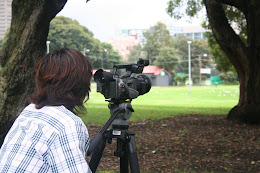Newsletter: aM i a Player3
1. Topic
The topic of this project for newsletter composed of print and online version is MP3 players. This newsletter will be named "aM i a Player3 (Am I a player?)" that could emphasise the main word, MP3. The newsletter will convey new movements and information about new MP3 player products and purchasing prices.
2. Goals
The purpose of this project is to provide useful information by print and online method. One in 10 U.S. adults, about 22 million people, has a MP3 player (Ranger 2005, para. 1). Even though MP3 players have become popular music player, this is still recognised something difficult to enjoy the music because this requires technical environment, such as the Internet and computer. Moreover, some MP3 magazines are using technical words which are difficult to understand in their reviews. This newsletter will be easy to read and enjoy new technical issues and knowledge helping MP3 players. It will be able to be substantial purchasing guides of new MP3 products.
3. Target Market
The target market of the newsletter varies in different methods. Print version targets localised in Sydney, Australia, whereas online version targets world-wide. The global sales of MP3 players have been rapidly increasing. It had increased twice from U$ 23.10 billions in 2003 to U$ 46.60 billions in 2006. In addition, the prospect of this consumption is up to U$ 57.70 in 2008 ("I Want My MP3" 2004, p. 21). That is how the newsletter (online version) targets world-wide. However, the prices of MP3 players are different at each local market. Thus, print version (if it includes the price information) must have targeted by regional markets.
According to the Nielsen Media Research (cited in Commercial Radio Australia 2006), the age of 25-39 years is 32% of MP3 player owners and the age of 14-24 years is 41% of MP3 player owners. The survey tells us that the main users of MP3 player are posited at the age of 14-39 years (73%). As a result this age also could become the target audience of the newsletter.
4. Content
Both of the newsletters, print and online versions, convey four main contents. These contents are organised to support reader’s real acts. It could be structurally from induction of interest to making a purchase (Whitbread 2001, p. 2).
NEWS
Deliver new technical issues, such as release the high capability memory chip.
REVIEW
Examine the features of new MP3 player with images.
STORE
Recommend recently MP3 players with main specs and retail prices.
GLOSSARY
Introduce useful words about MP3, such as codec, ID3 and Ogg.
5. Design Approach
The design approach of this is designed for readers in the target market. This approach should try to communicate information easily to understand by logical order and appropriate language (Whitbread 2001, p. 3). Although the target readers are interested in the same topic, MP3 player, each reader has different experiences and knowledge. Therefore, this newsletter will use moderate words, tone and images for the target age (14-39 years) in order to cover every reader.
5.1 Print Version
No chosen newsletter is just paper, not information. The newsletter of print version should be more attractive rather than online version. Shushan et al (1991, p. 3) state that newsletter must belong to readers to satisfy that readers' needs or wants the information, and to get readers' attention. Thus, his will use strong and simple words with big size font with colourful MP3 images to be recognised that this is about MP3 and this has something I want to know about MP3 in front page.
5.2 Online Version
The merit of online version is that it can combine large amount of the information. The online version of the newsletter will conveys larger information than the print version. According to Williams (1994), elements of newsletter can connect, relate and unify with the other information by placement. Online newsletter may be the next step of the print version so this must have more specific information and arrange clearly. An example of this is 'MP3 Glossary'. The print will describe meaning of a couple of words but the online will give more describing words to readers in the website.
References
'I Want My MP3' 2004, PC Magazine, 16 November, p. 21.
'Radio, MP3 Devices and Podcasting' 2006, National Survey Results: Survey 6, Commercial Radio Australia.
Ranger, S. 2005, 'IPod and MP3 Player Ownership Soars', viewed 23 November 2007, <http://www.vnunet.com/vnunet/news/2126781/ipod-mp3-player-ownership-soars>.
Shushan, R., Wright, D. & Lewis, L. 1991, 'Effective Communication in an Information Environment', Desktop Publishing by Design, Microsoft Press, pp. 2-9.
Whitbread, D. 2001, 'What Does Design Do?', The Design Manual, UNSW Press, pp. 2-5.
Williams, R. 1994, 'The Four Basic Principles', The Non-Designer's Design Book, Peachpit Press, CA.

 Who is the dog? And who wag the dog? Mr Fix-it, Brean is doing well his job and Mr President does not show his face. By the way, for whom the election doing. Even though Brean's job is fixing problems in the White House, his job is faking to the public, and then the people do that re-elect the Mr President.
Who is the dog? And who wag the dog? Mr Fix-it, Brean is doing well his job and Mr President does not show his face. By the way, for whom the election doing. Even though Brean's job is fixing problems in the White House, his job is faking to the public, and then the people do that re-elect the Mr President.




